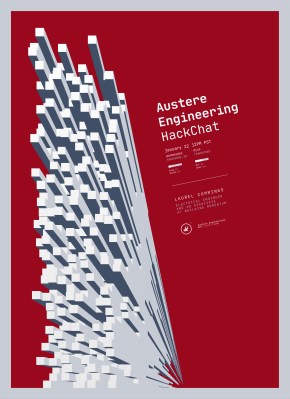Join us on Wednesday, January 22 at noon Pacific for the Austere Engineering Hack Chat with Laurel Cummings!
For most of us, building whatever it is that needs building is something that occurs in relative comfort and abundance. Sure, there are cold workshops and understocked parts bins to deal with, but by and large, we’re all working in more or less controlled environments where we can easily get to the tools and materials we need to complete the job.
 But not all engineering is done under such controlled conditions. Field operations often occur miles from civilization, and if whatever you need is not in the back of the truck, it might as well not exist. At times like this, the pressure is on to adapt, improvise, and overcome to get the job done, especially if people’s lives and well-being are at stake.
But not all engineering is done under such controlled conditions. Field operations often occur miles from civilization, and if whatever you need is not in the back of the truck, it might as well not exist. At times like this, the pressure is on to adapt, improvise, and overcome to get the job done, especially if people’s lives and well-being are at stake.
All of this is familiar territory for Laurel Cummings, an electrical engineer and an associate at Building Momentum, a technology development and training concern based in Virginia. Her job is to get out in the field and work with the company’s mainly military and corporate clients and help them deal with the challenges of austere environments, including disaster response efforts.
From a North Carolina beach ravaged by Hurricane Florence to the deserts of Kuwait, Laurel has had to think her way out of more than a few sticky situations. Join us as we discuss what it takes to develop and deploy field-expedient solutions under less-than-ideal situations, learn how to know when good enough is good enough, and maybe even hear a few war stories too.
 Our Hack Chats are live community events in the Hackaday.io Hack Chat group messaging. This week we’ll be sitting down on Wednesday, January 22 at 12:00 PM Pacific time. If time zones have got you down, we have a handy time zone converter.
Our Hack Chats are live community events in the Hackaday.io Hack Chat group messaging. This week we’ll be sitting down on Wednesday, January 22 at 12:00 PM Pacific time. If time zones have got you down, we have a handy time zone converter.
Click that speech bubble to the right, and you’ll be taken directly to the Hack Chat group on Hackaday.io. You don’t have to wait until Wednesday; join whenever you want and you can see what the community is talking about.
















I love all this sort of stuff, using PET bottles for shrink wrap, coathangers for welding, and my current interest du jour, seeing how many things you can make casein based glue out of. In basic terms, you acquire casein from milk (Fresh/UHT milk may need a mild acid [Vinegar, lemon juice etc] to cause a clotting process, filter the lumps, that’s what you need), sour milk, soft cheese, powdered protein drink if that’s all the looters left in the store, then you mix it up with an alkaline substance, lye, potassium hydroxide from wood ash, calcium hydroxide you baked out of sea shells or egg shells, and sufficient water (some of your sources may be wet enough) and hey presto you’re making medieval epoxy. Yes I’m short a few finer points there, google is your homework helper.
Handy Hint: Always carry a late 90s vintage Yuppie, the magnesium frame in his PDA can be used to light off thermite.
I’ve wanted to experiment with casein, but I haven’t gotten around to it yet. I’m surprised that more hackers haven’t tried it; it looks quite interesting. Thanks for the info; it will save me a few minutes of googling if/when I finally try anything casein-related.
Theoretically it can survive low temperature soldering, so could embed or glue down contacts maybe. Even more exciting for that is a variant called galalith, but every page or vid claiming to make it so far has just made a big blob of casein goop and said “this would be galalith if I added formaldehyde” yeah, very helpful. Not that formaldehyde is easy to scavenge (Maybe you could solar still it out of vegetation) but it implies possibilities like making an expedient replacement distributor cap or rotor arm or something. Or being a very useful durable setting resin made under controlled conditions.
Anyhoo, here’s an old technical manual about casein https://archive.org/details/caseinitsprepara00scherich/page/n6
The manual looks interesting! The casein/galalith confusion is unfortunate; the instruction “just add some formaldehyde” isn’t very trivial. It’s fortunate that formaldehyde isn’t required for all casein applications.
aka MacGyvering. ;-)
Sometimes I don’t have handy the resources I need to polish a project, so thrifting a solution is something I do often: from using electrical tape to do unions, to using points of tin to fix a transformer in place.